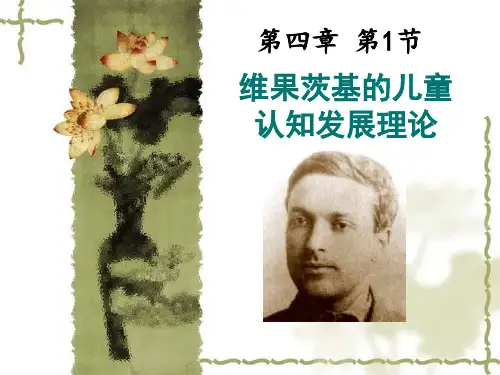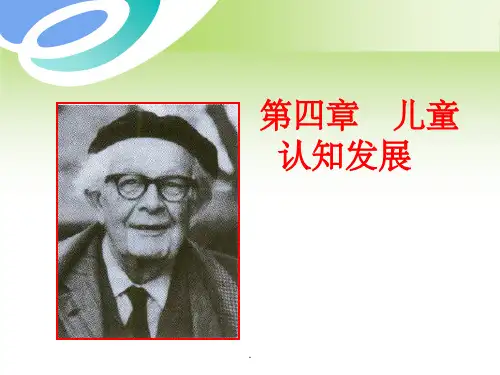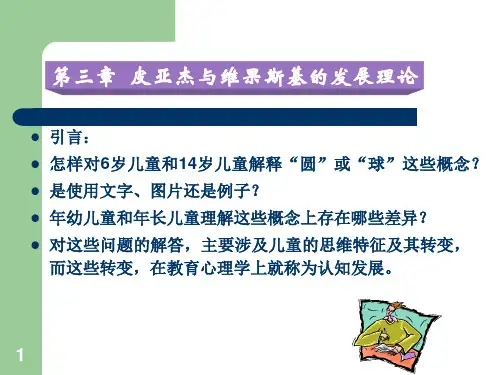皮亚杰与维果斯基ppt课件
- 格式:ppt
- 大小:526.00 KB
- 文档页数:21
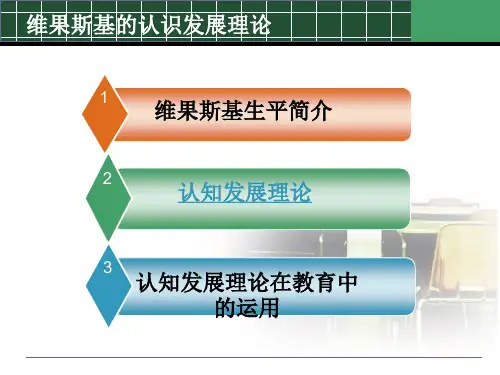
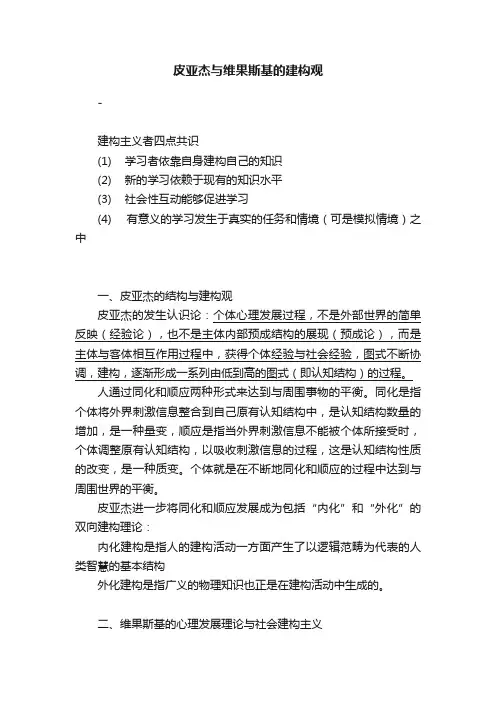
皮亚杰与维果斯基的建构观-建构主义者四点共识(1) 学习者依靠自身建构自己的知识(2) 新的学习依赖于现有的知识水平(3) 社会性互动能够促进学习(4) 有意义的学习发生于真实的任务和情境(可是模拟情境)之中一、皮亚杰的结构与建构观皮亚杰的发生认识论:个体心理发展过程,不是外部世界的简单反映(经验论),也不是主体内部预成结构的展现(预成论),而是主体与客体相互作用过程中,获得个体经验与社会经验,图式不断协调,建构,逐渐形成一系列由低到高的图式(即认知结构)的过程。
人通过同化和顺应两种形式来达到与周围事物的平衡。
同化是指个体将外界刺激信息整合到自己原有认知结构中,是认知结构数量的增加,是一种量变,顺应是指当外界刺激信息不能被个体所接受时,个体调整原有认知结构,以吸收刺激信息的过程,这是认知结构性质的改变,是一种质变。
个体就是在不断地同化和顺应的过程中达到与周围世界的平衡。
皮亚杰进一步将同化和顺应发展成为包括“内化”和“外化”的双向建构理论:内化建构是指人的建构活动一方面产生了以逻辑范畴为代表的人类智慧的基本结构外化建构是指广义的物理知识也正是在建构活动中生成的。
二、维果斯基的心理发展理论与社会建构主义从历史的观点,在社会环境之中,在同社会环境作用不可分割的联系中研究意识和心理发展。
人的心理过程变化是以特殊的“精神生产工具”为中介,其中重要的是各种符号系统,尤其是语词系统。
通过这些中介工具的影响,人能在改变环境的同时,调控自己的行为和心理过程,使自己的行为更具理性和自由度。
个体的学习是在一定的历史、社会文化背景下进行的,社会为个体学习发展提供重要支持和促进。
最邻近发展区理论。
以维氏为代表的社会建构主义强调认知过程中学习者所处社会文化历史背景作用,同时考虑主客观知识并将二者结合起来,相互促进。
说明个体知识与社会相互联系的。
只有当个人建构的,独有的主观意义和理论跟特定社会文化背景中的共识相适应时,个体才有可能发展。
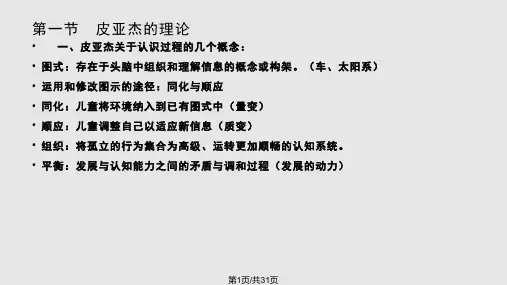


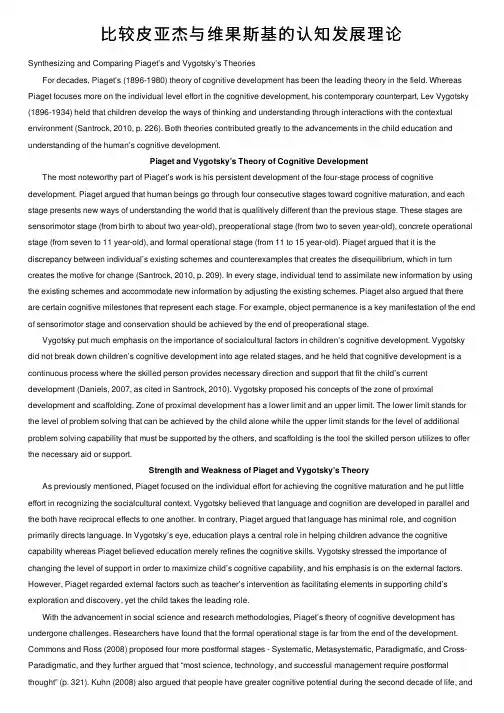
⽐较⽪亚杰与维果斯基的认知发展理论Synthesizing and Comparing Piaget’s and Vygotsky’s TheoriesFor decades, Piaget’s (1896-1980) theory of cognitive development has been the leading theory in the field. Whereas Piaget focuses more on the individual level effort in the cognitive development, his contemporary counterpart, Lev Vygotsky (1896-1934) held that children develop the ways of thinking and understanding through interactions with the contextual environment (Santrock, 2010, p. 226). Both theories contributed greatly to the advancements in the child education and understanding of the human’s cognitive development.Piaget and Vygotsky’s Theory of Cognitive DevelopmentThe most noteworthy part of Piaget’s work is his persistent development of the four-stage process of cognitive development. Piaget argued that human beings go through four consecutive stages toward cognitive maturation, and each stage presents new ways of understanding the world that is qualitively different than the previous stage. These stages are sensorimotor stage (from birth to about two year-old), preoperational stage (from two to seven year-old), concrete operational stage (from seven to 11 year-old), and formal operational stage (from 11 to 15 year-old). Piaget argued that it is the discrepancy between individual’s existing schemes and counterexamples that creates the disequilibrium, which in turn creates the motive for change (Santrock, 2010, p. 209). In every stage, individual tend to assimilate new information by using the existing schemes and accommodate new information by adjusting the existing schemes. Piaget also argued that there are certain cognitive milestones that represent each stage. For example, object permanence is a key manifestation of the end of sensorimotor stage and conservation should be achieved by the end of preoperational stage.Vygotsky put much emphasis on the importance of socialcultural factors in children’s cognitive development. Vygotsky did not break down children’s cognitive development into age related stages, and he held that cognitive development is a continuous process where the skilled person provides necessary direction and support that fit the child’s current development (Daniels, 2007, as cited in Santrock, 2010). Vygotsky proposed his concepts of the zone of proximal development and scaffolding. Zone of proximal development has a lower limit and an upper limit. The lower limit stands for the level of problem solving that can be achieved by the child alone while the upper limit stands for the level of additional problem solving capability that must be supported by the others, and scaffolding is the tool the skilled person utilizes to offer the necessary aid or support.Strength and Weakness of Piaget and Vygotsky’s TheoryAs previously mentioned, Piaget focused on the individual effort for achieving the cognitive maturation and he put little effort in recognizing the socialcultural context. Vygotsky believed that language and cognition are developed in parallel and the both have reciprocal effects to one another. In contrary, Piaget argued that language has minimal role, and cognition primarily directs language. In Vygotsky’s eye, education plays a central role in helping children advance the cognitive capability whereas Piaget believed education merely refines the cognitive skills. Vygotsky stressed the importance of changing the level of support in order to maximize child’s cognitive capability, and his emphasis is on the external factors. However, Piaget regarded external factors such as teacher’s intervention as facilitating elements in supporting child’s exploration and discovery, yet the child takes the leading role.With the advancement in social science and research methodologies, Piaget’s theory of cognitive development has undergone challenges. Researchers have found that the formal operational stage is far from the end of the development. Commons and Ross (2008) proposed four more postformal stages - Systematic, Metasystematic, Paradigmatic, and Cross-Paradigmatic, and they further argued that “most science, technology, and successful management require postformal thought” (p. 321). Kuhn (2008) also argued that people have greater cognitive potential during the second decade of life, andformal operational stage is just the beginning to realize this potential. Kuhn held that we need to cultivate supporting environment to maximize every individual’s full potential (p. 53). Secondly, cognitive abilities does not exactly follow the pattern what Piaget theorized. Some cognitive abilities could emerge earlier than the norm, and some could delay. Children who are exposed to object manipulation earlier have greater possibility to grasp the conservation earlier than the children who have less real life experience.Vygotsky’s theory has not undergone rigorous empirical studies (Santrock, 2010, p. 230). This is partly because Vygotsky’s theory had not been recognized by the most of the world the same as Piaget’s, and partly because Vygotsky’s theory was not specific enough. For example, Vygotsky did not theorize major milestones in children’s cognitive development path. Also, Vygotsky overemphasized the role of language in thinking (Santrock, 2010, p. 231) where he argued that children progressively internalize their egocentric external speech to form their thoughts. Vygotsky maintained that socialcultural factors exert much on the cognitive development, and guidance would help children reach the upper limit of their zone of proximal development; however, too much support would also inadvertently cause children’s dependence.ConclusionPiaget’s theory starts from nativist’s point of view, emphasizing the importance of cognitive development milestones while maintaining that education and environment can also refine the cognitive skill. Vygotsky’s theory revolves around from the social interactionist’s point of view, putting feet hard on the socialcultural factors. Both Piaget 's and Vygotsky's theory of cognitive development provide us lenses in looking into human’s most powerful capability – cognition, and their theories will continue serving as the cornerstone for education.ReferencesCommons, M. L., & Ross, S. N. (2008). What postformal thought is, and why it matters. World Futures, 64, 321–329. Kuhn, D. (2008). Formal operations from a twenty-first century perspective. Human Development, 51, 48–55.Santrock, J. W. (2010). A topical approach to life-span development (Fifth Edition). New York: McGraw-Hill.。

